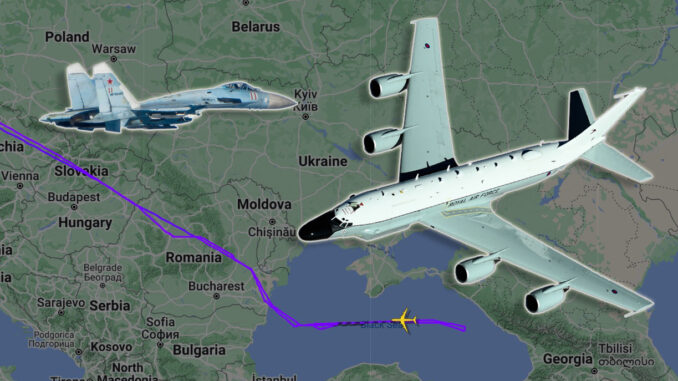[ad_1]

Leaked Pentagon documents provide a different account of the incident over the Black Sea.
As we reported in detail last year, in a statement updating MPs UK Defence Secretary Ben Wallace said that a Russian Su-27 Flanker “released a missile in the vicinity of the RAF Rivet Joint beyond visual range” in what he described a “potentially dangerous engagement” occurred on Sept. 29, 2022, over the Black Sea.
On that day, a Royal Air Force RC-135W performing a routine surveillance patrol in international airspace was intercepted by two armed Russian Su-27 Flanker jets that “interacted” with the British spyplane for about 90 minutes. At a certain point, one of the two fighters released a missile. Wallace attributed the incident to “technical malfunction,” a version in agreement with the outcome of the Russian investigation.

However, the close encounter has been described in leaked U.S. military documents part of the so-called Pentagon Leaks, as much more dangerous than previously reported. As explained by the Washington Post, the Pentagon document, labeled “SECRET/NOFORN,” which is a classification that demands its contents not be shared with non-US citizens, refers to the incident as a “near-shoot down of UK RJ,” where “RJ” is a reference to a commonly used nickname for the Rivet Joint spy plane.
Neither the British nor the Russian embassy did respond to a request and U.S. defense officials declined to comment, the WP said.
According to the paper, the leaked document contains details of other close encounters between Russian fighters and U.S. British and French aircraft between October and the end of February. In one such episodes, on Dec. 30, 2022, a British “Rivet Joint”, escorted by two aircraft RAF Typhoons, was intercepted by Russian planes that came within 30 meters of the RC-135W; on Mar. 14, 2023, a Russian Su-27 Flanker fighter jet and a US MQ-9 Reaper Remotely Piloted Aircraft were involved in an inflight collision over the Black Sea. The mid-air collision damaged the American unmanned aircraft and the U.S. Air Force was forced to ditch in international waters. As the footage released in the days after the incident proved, the Su-27 hit the MQ-9 while dumping fuel over the Reaper.
Since then, NATO manned and unmanned ISR (Intelligence Surveillance Reconnaissance) platforms have continued to operate in the Black Sea region, even though, most of them (at least, those that can be tracked online on flight tracking websites and apps) have remained over land or quite distant from Crimea.
Anyway, the incident underscores the inherent risk of escalation that characterizes this kind of close encounters: had it gone differently, with the Russian Flanker downing a crewed NATO aircraft, the clash might have forced the U.S. and its allied into a direct war with Russia. In fact, under the NATO treaty, if a member of the military alliance is the victim of an armed attack, all members of the alliance will consider it an attack and respond collectively.
Western military officials have so far managed to help the Ukrainian military and gather information without being drawn directly into the conflict with Moscow: they have always said that they support Kyiv but are not at war with Moscow. But the situation might escalate quite rapidly in case of incident.

[ad_2]
Source link
